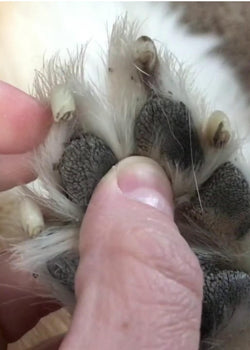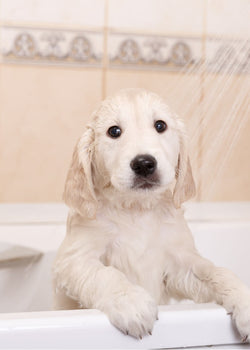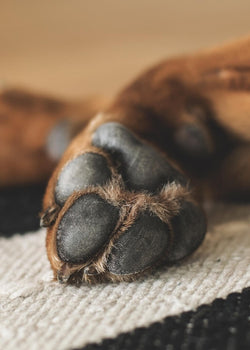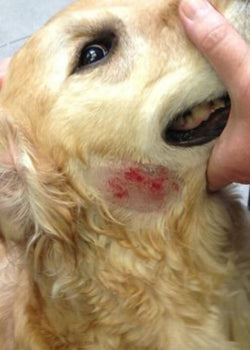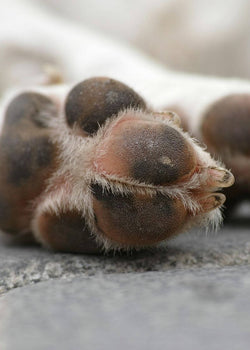Common dog paw problems and how to prevent them?
Dogs’ paws do a lot of work for their bodies. Besides their noses that allow them to discover the world, their paws present the second most important tool for exploring.As a dog owner, you’ve probably noticed that your pooch licks his paws occasionally.
However, have you ever wondered what could be the reasons for such behavior? While some dogs don’t develop any paw issue during their lifetime, there are those that are more prone to experience some of them.
What are the most common symptoms of dog paw issues?

It’s a fact that our pets spend so much time walking, running, digging and jumping by their feet. That’s why we shouldn’t be surprised by certain accidents and issues that can happen.
Regularly checking your pet’s paws and observing his behavior presents the best solution for many health problems. So far, you probably noticed that your dog’s paws don’t look the same all year. In certain seasons, they become dry and cracked.
The same things happen to humans’ hands. So, if you take care of your own hands, then why not to provide your pet with the appropriate care too?
1. WHY DO DOGS LICK AND CHEW THEIR PAWS?
The first sign of paw inflammation is when you start noticing your pooch licks and chews his paws excessively. This kind of condition is followed by the dog’s nervousness and his inability to calm down.
Excessive licking, scratching and chewing can cause an even worse condition such as making wounds that can become a perfect place for bacteria growth. In case you see your pooch licks only one paw then you can be sure the issue is localized to only one place.
In such a situation, a dog usually got an insect bite, stepped on some chemical, or is having a cut.
2. INFLAMED, SWOLLEN AND RED PAWS
Another sign that goes together with the previous symptoms are the inflamed, swollen and red paw pads. Swollen dog paws can point to issues such as allergies or stuck plant and other small objects in a dog’s pads.
3. CRACKED DOG PAWS
Cracked dog paws present one of the most common problems in all dog breeds. It usually occurs in winter conditions, due to different chemical burns or by walking on sharp terrains.
Therefore, dog owners who like to go hiking with their furry friends need to pay special attention to their paw care. In the continuation of the article, you’ll find the rest of the causes for this kind of condition.
4. ULCERS
Ulcers in dogs can be found anywhere on their bodies, even on their paws. They present lesions and erosions that affect deeper layers of the skin. A dog with ulcers experiences pains, so that’s why is advisable to treat them on time. Ulcers on dog paws go together with hair loss (alopecia), red and swollen lesions, discharge, crusts, and depigmentation. There’s a wide variety of conditions that can result in such a condition. The first on the list is Pododermatitis.
Pododermatitis is a skin issue that happens due to food or environmental allergy. Environmental type of allergy includes different chemical burns, and allergic reactions to different allergens such as dust, dirt, and mites.
In the case when a dog is intolerant to some type of food, his paws may become itchy and swollen. Due to the dog’s scratching and biting, his paws develop ulcers. In this case, the only treatment that can actually help is an antibiotic therapy and topical sprays that should be prescribed by a vet.
5. THE BAD SMELL COMING FROM PAWS
According to hundreds of dog owners’ opinions, the paws of their dogs have the smell of popcorn. However, have you ever wondered why it happens?
First of all, a smell of corn chips coming from your furry friend’s feet is not always to become worried. That kind of yeasty smell is caused by bacteria that present a natural part of your dog’s paws. On the other hand, if you started to notice some unusual change, redness and cracked skin, it’s time to react. Note that the dog’s fur between his toes can also cause a certain dose of unusual smell. That’s why is advisable to trim that fur frequently. Otherwise, when you mix the sweat and corn chips smell, the result is not so thrilling.
A seriously bad odor of your dog’s paws may point out to other conditions as well. It could be a bacterial infection which can be solved by using the prescribed topical sprays and antibiotic treatment. Maybe you’ve already heard for this, but putting cornstarch between the dog’s toes can help in picking up the sweat and excessive moist. The same rule for treating can be applied to the dog’s folds too.
A stuck foreign object, plant seed or the piece of grass can also make the paws stinky due to infection. Ingrown nails and toe injuries are usually followed by redness and smelly yellow discharge that should be properly cleaned. After the procedure of disinfection is done you can apply Flora 4 Pets skin & cracked dog paw balm with marigold and chamomile. The balm is full of powerful herbals that provide the anti-inflammatory, anti-bacterial and anti-fungal effect.
What are the main causes of paw issues and injuries in dogs?
1. ALLERGIES
Allergy type of pododermatitis occurs due to different environmental allergens such as dirt, dust, mites or chemicals. It requires daily paw cleaning with a wet towel, baby wet wipe or washing them in water in order to remove all the allergens. In some cases, the root for such an issue may present the food type of allergy. It’s usually corn, soy, and wheat rich food that causes paw and skin allergies in dogs. On the other hand, a dog can also show an allergic reaction due to an insect bite when should be applied a topical spray or cream on the inflamed spot.
Corn, soy, and wheat rich food causes paw and skin allergies in dogs.
2. FUNGAL AND BACTERIAL INFECTION
When an untreated pododermatitis grows into an infection, a dog may experience painful ulcers, blisters and even show a yellow discharge. Such a condition requires the prescribed antibiotic therapy and wrapping the paws into bandages for a few days. That’s the only way for stopping a pooch from licking paws and further injuries.
Onychomycosis is another fungal infection that affects the nail bed. It’s a painful condition that occurs due to ringworm infection. The most common symptoms that follow this condition are chewing at the claws, redness, swelling, and deformity of the claws. Since this kind of condition is deep-seated, it requires the help of a vet. The treatment may last up to several months in order to clean all the fungus.
3. NAIL ISSUES (INGROWN AND TORN NAILS)
Ingrown nails are painful not only for people but also for dogs. They usually occur when the nails have not been cut regularly. If your dog’s nail is growing into the paw, it may lead to the dog’s inability to walk and developing a different infection. This kind of condition can be solved by carefully clipping the dog’s nails by paying attention not to hurt the quick.
4. DRY AND CRACKED PAW PADS
These types of symptoms may occur due to a number of reasons. Actually, they are the first signs that point out to dozens of potential roots to your furry friend’s paw health issues. Dry and cracked dog paws are not only unpleasant to see, but they also present the perfect place for developing some more serious paw issues. Cracked pads offer a free entrance to fungal, bacterial and parasite infections. Therefore, prevention is over needed. It’s better to ‘perform an attack on the root of the problem’.
5. BURNED DOG PAWS AND BLISTERS
Different burns and blisters on dog’s paws mostly occur when a dog was allowed to walk on hot pavements or stepped to different chemicals. Although dog’s pads are thick, they can’t sustain corrosive substances, heat, radiation, and acids.
Therefore, it’s very important to forbid a dog to walk on unknown terrains that can cause him to experience not only burns and blisters but also infections and dehydration. Depending on a case of burns, a dog may experience from mild to severe pains.
Besides pains, such a destroyed dog’s skin is followed by pains, blotchy, red and white to skin with the lack of blood, and edema. Since it can’t be healed in home conditions, it’s advisable to take a dog to the vet right after the accident happened.
A dog will probably get an infusion in order to decrease the body temperature, antidepressant therapy (in the case when a dog’s feeling stressed), and the antibiotic treatment.
6. CUTS AND ABRASIONS
This type of paw injuries usually happens when you take your dog to walk on unknown and sharp terrains. Since cuts and abrasions are painful, it’s advisable to wash the wound with 3% hydrogen first and then to gently clean it with a cotton ball. In that way, you’ll remove the dirt from the cut and be able to see if there are some foreign objects stuck in your dog’s paw. Foreign objects can be removed by a previously disinfected tweezers, but in case you think you can’t do it alone, the best solution is to take your furry friend to see a vet. When the process of cleaning the cut is finished, a dog will have to wear a bandage for a few days.
7. PARASITES
Parasites come in many symptoms and levels of severity. They may affect not only inside the dog’s body but also his skin and paws. One of the most common parasitic infections of the dog’s paws and skin is called Demodicosis. It is a parasitic infection caused by a mite Demodex canis that is a part of a dog’s skin. When the number of mites increases due to a dog’s weak immune system he experiences inflamed and itchy skin that ends up in hair loss. This kind of condition can be confirmed by a biopsy and microscopic checks.
8. FROSTBITES
Otherwise called congelation, frostbites occur due to a prolonged dog’s walking on cold pavements. It occurs in dog’s ears, paws, tail, nose, and scrotum. A pooch that walked on snow for a long time can catch ice balls between the toes and get ice burns. Therefore, it’s advisable to pay attention to providing a doggie with the appropriate footwear when going for a walk.
The pain your furry friend can experience due to frostbite is immeasurable! It’s followed by swelling, blisters, ulcers and skin falling after a couple of days. We don’t even need to mention the smelly odor and bacteria a dog can get.
9. TICKS
Despite the fact they’re so small and look harmless, these small bugs can actually cause serious issues not only in pets but in every human being on Earth. Since we can find them everywhere in nature, falling from trees and in the grass, it’s important to daily check your dog’s body.
Ticks like warm and dark places to hide we can usually find them around dog’s tail, and between the toes. If it’s not noticed and pulled out on time, it can cause serious health issues such as Lyme disease and Rocky Mountain spotted fever. If you don’t have any experience in removing ticks, we advise you to take your dog to the vet. It’s important not to leave any tick’s leg, otherwise, the infection may develop.
10. MITES
Well, those tiny mites/ mange can really cause a lot of problems. Your four-legged friend may become so itchy and nervous that you’ll probably not know how to help him in those moments. There are two types of mites- Sarcoptic mange and Demodectic mange. Sarcoptic mange is caused by mite Sarcoptic scabe that burrows within the outer layer of a dog’s skin. Since the dog can’t control himself, his paws become hairless and develop wounds.
Unlike Sarcoptic mange, Demodectic mange is caused by Demodex canis that lives within the dog’s hair follicles. Luckily (or not) they can’t be transmitted to other dogs and animals. This type of condition is described by the blue or gray hairless paw skin, itchiness, and comedones.
11. ANXIETY
Companion and hunting dog breeds are at higher risk to suffer from a condition called dog separation anxiety. This kind of issue is followed by a dog’s strange behavior, howling, barking and scratching and licking his paws to blood. The fear a dog feels when he’s left alone is beyond limits. Therefore, if you already took your pooch to the vet and he told you that there isn’t any infection, then the cause may be the anxiety.
12. BOREDOM
This cause for your dog’s licking and chewing paws is not tightly connected with separation anxiety. It only means that your four-legged friend needs different interactive toys to play while you’re out of the home.
You can choose between different chewing and feeding toys for your pooch that releases the food every time he rolls the ball. However, it’s advisable not to overfeed the pooch with those treats, otherwise, it may lead him to obesity. For example, you can separate a certain amount of food from one of your dog’s meals for snacks.
13. GASTROINTESTINAL ISSUES
It’s nothing strange to see a dog that suffers from GI issues to excessively licking his paws. Inappropriate diet can be only some of the issues for your furry fellow’s suffer, so you’d better check it.
How to take care of the dog paws and what is the best prevention?

1. PEDICURE
One of the most important rules when owning a dog is to provide it with the best care. It includes not only nutrition but also cleaning his fur, regular grooming, going to the vet check, as well as taking care of his paws and teeth. Your dog’s nails should be regularly trimmed every 1-2 months. However, it depends on many reasons and some of them are age, activity, and environment. In other words, if you own an older dog that is not so active, you’ll need to cut his nail more often. In case you have an active dog that walks on different hard surfaces such as asphalt, it’s possible that you’ll have to do that every 2nd month.
You can be sure that it’s time for cutting when you hear his nails clicking on the floor while walking. The procedure of pedicure should be done carefully in order not to hurt a dog and not to cut the nail too deep. If the pooch acts uncomfortable, it’s advisable to feed him with some treats in order to keep his attention.
2. PAY ATTENTION TO WEATHER CONDITIONS
It might sound silly, but your dog needs shoes/boots equally like you. It’s the only way for providing him with total protection. You’ll certainly need to put some efforts to teach a dog to get used to wearing them, but have you ever thought how do his paws feel in winter or summer?
We don’t even need to mention a dangerous effect of road salt that can cause serious damage to your furry friend’s paws. Walking on cold pavements such as snow and ice is not a pleasant feeling despite the fact dogs have fur. Remember that those tiny body parts are the only hairless parts where dogs can sweat and regulate their body temperature. So, if they step on something cold, their body temperature goes down too.
Besides buying dog booties, it’s advisable to regularly clean paws by baby wet wipes and a wet towel. Daily washing pads with soap and water are not recommended because in that way you’ll remove the natural dog’s skin oils and worsen the symptoms.
On the other hand, walking on hot surfaces can also cause damage and burn your dog’s sensitive paw pads. For the summer, you can choose dog socks or mesh dog boots that are usually thinner. There are also socks with a non-slipping addition that are great for walking on different surfaces.
3. SOOTHE YOUR DOG’S PAWS WITH THE RIGHT PRODUCTS
Consider moisturizing your furry best friend’s paws daily with a paw balm that is rich in different natural ingredients. It will soothe even cracked and dry dog’s paw pads and provide the skin with elasticity.
Another great product presents the petroleum jelly. It’s recommended by the vets to massage dog’s paws with petroleum jelly in order to protect them from asphalt chemicals and street salt.
4. REGULARLY CHECK YOUR DOG’S PAWS
It might sound like a cliché but regularly checking your dog’s paws is the best prevention. Of course, regularly soothing the dog’s paws is also highly recommended.
Hyperkeratosis in dog presents a disease that can affect nose and paws. It occurs when a body produces too much keratin. Hyperkeratosis is followed by ugly-looking crusts on a dog’s nose and hair on its paw pads.
Those tiny body parts discover a lot about your dog’s overall health. They serve not only to regulate body temperature but also tell a lot about your dog’s diet. Yes, you’ve heard it well. Excessive paw licking and dry skin often point out to pH imbalance. It means that your furry friend doesn’t have enough meat in his diet.
In order to make sure the paws are in good condition, it’s advisable to touch the pads and check if they have enough moisture and shine.
5. APPLY FIRST AID
We all know that it can be really stressful to see your pet has got a cut, burn or some foreign object stuck in his paw, however, you’re the only one who can help him in such a situation. Before you take him to the vet, it’s advisable to clean the inflamed spot. That’s why you need to stay prepared for sudden accidents and have the over needed first-aid products.
One of the most important products for treating every kind of cut, irritation, wound or abrasion is to apply 3% hydrogen and medical gasoline. Do not use alcohol because it will sting it cause serious pains. Cleaning should be performed by putting previously mentioned products on sterile gauze. When the procedure is finished, it’s advisable to put a bandage for a few days in order to escape any further infection. After you took your lovely pooch to the vet, you’ll know how the healing process should go.
For tired dog paws that had a long walk on different surfaces in cold or hot weather conditions, it’s good to use a Paw cooling & moisturizing spray with rosewood, geranium, and peppermint. It is ideal for rehydrating paws on hot days or in winter months when the air in our homes becomes dry.

